February 22nd, 2018
BURLINGTON, ON
The decision to turn what has been a location where buses came in, picked up passengers and moved on serving as a transfer station turned into a mobility hub has confused many, particularly in the downtown core.
Most people see the small terminal on John Street as not much more than a bus station.
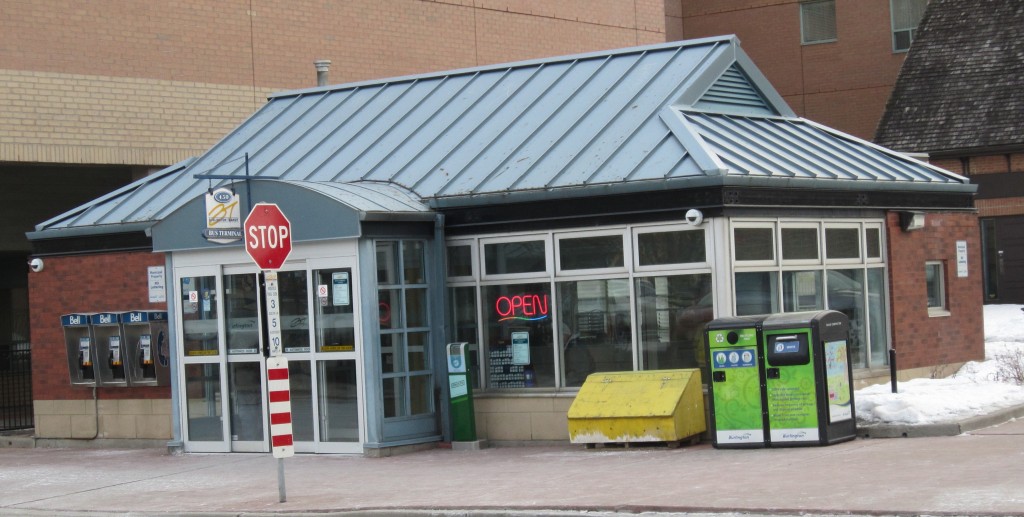
At one point the city considered closing the terminal – now it is going to be upgraded to a Anchor level mobility hub.
Turns out that there has been a lot of thinking taking place that since well before 2014 when the Provincial Policy Statement was revised.
Paul Brophy, Gary Scobie, Brian Jones, Elaine O’Brien, Brian Aasgaard, Lisa Kearns, Michael Hriblijan, My Dang, Deby Morrison and Nancy Cunningham delegated on the issue at recent city hall meetings
The issue for the delegations was that the bus terminal on John Street does not make the Downtown a Mobility Hub and that the Downtown area isn’t a Mobility Hub. The delegations wanted to know how the downtown got designated as an Urban Growth Centre?
The planning department provided the following response. It is included in the background papers that will be put before city council on February 27th.
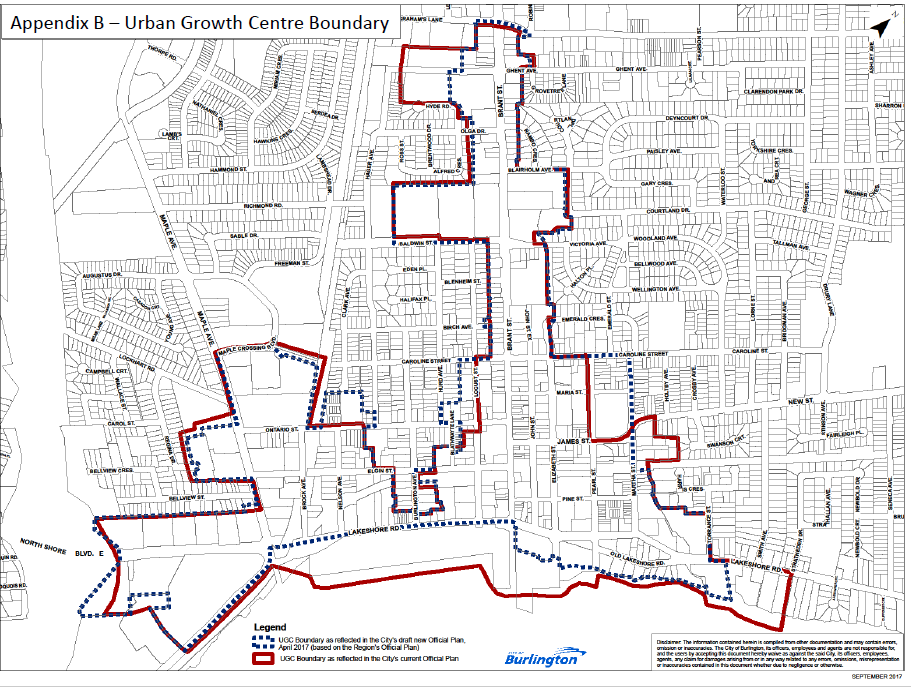
The current Urban Growth Centre boundary – a quick look at the map suggests the gerrymandering has been done. Does the public really understand the impact of this boundary?
“ The identification of the Downtown as a Mobility Hub originated in the 2006 Places to Grow document, which identified Downtown Burlington as an Urban Growth Centre (UGC). At the time the Growth Plan was being developed, the Downtown had been the subject of on- going strategic public investments and revitalization efforts by the City, such as Momentum 88 and Superbuild (2001) funding.
“The identification of Downtown Burlington as an Urban Growth Centre as part of the Places to Grow document further supported and built upon these efforts by establishing Downtown as an area for growth and investment that would support the Downtown’s long-term success.

The GO train system was going to move people efficiently with 15 minute service and be electrified to help out with climate change.
“In 2006, Metrolinx and the Province introduced a Regional Transportation Plan called “The Big Move” for the Greater Golden Horseshoe, which contained action items to develop and implement a multi-modal transportation plan. As part of this, a connected system of mobility hubs throughout the GTHA was envisioned to serve as places where connectivity between different modes of transportation including walking, biking and transit would come together seamlessly and where there is an intensive concentration of living, employment, shopping and/ or recreation.
“In addition to serving as transit hubs, these areas have the potential to become vibrant places of activity and destinations in and of themselves. Mobility Hubs are intended to become locations for major destinations such as office buildings, hospitals, education facilities and government services. Two types of mobility hubs were identified and defined within the Big Move: Anchor Hubs and Gateway Hubs.
“Anchor hubs are defined as those areas that have strategic importance due to their relationship with provincially identified Urban Growth Centres, as set out by the Places to Grow Plan. Downtown Burlington is identified as an Anchor Mobility Hub due to its relationship with the City’s Urban Growth Centre; its potential to attract and accommodate new growth and development; the convergence of multiple local transit routes through the Downtown Bus Terminal; the linkages to GO Transit, the other Mobility Hubs and surrounding municipalities; and its ability to achieve densities that would be supportive of a multi-modal transportation plan.
“At the January 23, 2018 Planning and Development Committee meeting a motion directing staff to work with the province to remove the mobility hub classification for the downtown, and shifting the UGC from downtown to the Burlington GO station failed.”
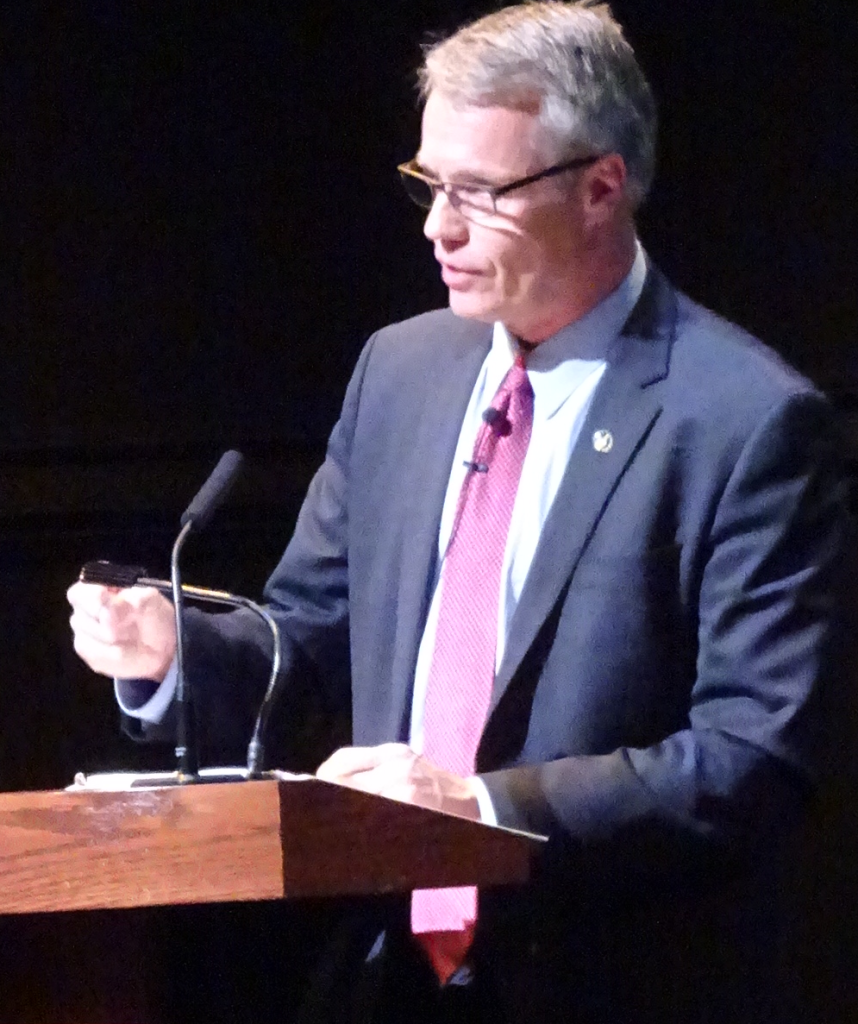
Mayor Rick Goldring explaining Intensification – the public was told then that the changes were not going to change the Burlington “we all lived in”. The 23 storey condo city council approved and the 26 storey condo the OMB said could be built xx that belief.
During the lead up to the serious work being done on what started out as a re-write of the Official Plan the Mayor gave several presentations on intensification. His objective at the time was to assure people that the growth that was going to take place would not change the character of the city.
The public was still concerned then – and they are very concerned now.
What has been come increasingly clear is that it is provincial directions – Place to Grow – the Big Move – the Public Policy Statement that was issued in 2014 and revised in 2017 aren’t fully understood or appreciated by the vast majority of the public.
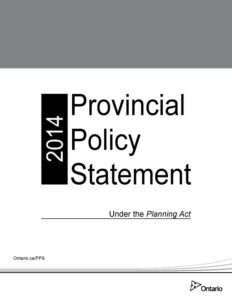 A Provincial Policy Statement is issued under section 3 of the Planning Act. The 2014 Statement became effective April 30, 2014 and applies to planning decisions made on or after that date. It replace the Provincial Policy Statement, 2005.
A Provincial Policy Statement is issued under section 3 of the Planning Act. The 2014 Statement became effective April 30, 2014 and applies to planning decisions made on or after that date. It replace the Provincial Policy Statement, 2005.
That 2014 Statement got replaced in 2017.
Much of this happened while the Planning department underwent significant leadership and staff changes.
The public is struggling on several levels: to get their council to be more transparent and to listen to what the public has to say.
The public has yet to hear a believable explanation on why the draft Official Plan adoption cannot be deferred until after the October municipal direction. The argument that it has to be approved now because if it is deferred it might mean that any new Councillors would need six months to gain an understanding of what these complex plans are all about.
The fact is that any plan that gets approved in the near future sits on a shelf until the sometime in 2019 when it gets reviewed by the Regional Planning & Public Works Committee.
The provincial government explains on its web site that “the long-term prosperity and social well-being of Ontario depends upon planning for strong, sustainable and resilient communities for people of all ages, a clean and healthy environment, and a strong and competitive economy.

The Escarpment defines the city of Burlington. No development except for within the three settlement areas and even there development is very limited.
“Ontario is a vast province with diverse urban, rural and northern communities which may face different challenges related to diversity in population, economic activity, pace of growth and physical and natural conditions. Some areas face challenges related to maintaining population and diversifying their economy, while other areas face challenges related to accommodating and managing the development and population growth which is occurring, while protecting important resources and the quality of the natural environment.
“The Provincial Policy Statement focuses growth and development within urban and rural settlement areas while supporting the viability of rural areas. It recognizes that the wise management of land use change may involve directing, promoting or sustaining development. Land use must be carefully managed to accommodate appropriate development to meet the full range of current and future needs, while achieving efficient development patterns and avoiding significant or sensitive resources and areas which may pose a risk to public health and safety.
“Efficient development patterns optimize the use of land, resources and public investment in infrastructure and public service facilities. These land use patterns promote a mix of housing, including affordable housing, employment, recreation, parks and open spaces, and transportation choices that increase the use of active transportation and transit before other modes of travel.”
Dense stuff, complex stuff that the public is expected to understand while they decide which program they want to register their children in at Parks and Recreation or figure out how to get the permit they need for changes they want to make to their property.
There has to be a better way to comply with the changes the province has mandated.
















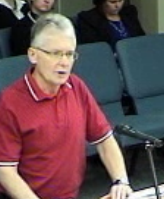
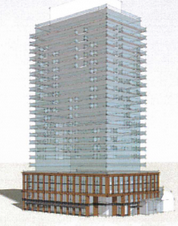
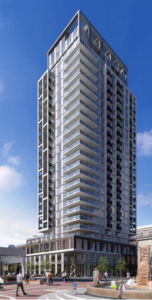




Don’t Central High School students walk to school? Why on earth would they need transit? Other than to get to Aldershot High School for the shared teams. But I am sure the HDSB pays for school buses for such ventures.
Sharon I can tell you that depending on the day there is about 40+ students taking Burlington Transit to and from Central High School spread out of three different routes.
According to more than one councilor we will only see 100 to 150 people added to the downtown per year over the next 50 to 70 years. Where is the ridership for the mobility hub going to come from?
Joseph Im going to go with a higher projection. A technical note that was included in the Downtown Mobility Hubs study indicated that at build-out for the Downtown (lets say 40 years) the population for the area would increase by just over 15,000 people. If half of these people decided to take transit thats 7,500 new riders which would mean 188 new riders a year. Given the emphasis for better transit and reduced car spaces in developments I don’t think that this would be too hard to achieve. You also have to account for the people outside of the Downtown that come in. More businesses, events, Central High School students and residents will contribute to the ridership.
TJBurl,
You can make any assumptions you want, to get any result you want, and that’s all you have done here.
It all sounds very rosy. You know, “Once Upon and Time”. This is fiction.
If you can’t do an analysis based on facts and reasonable relations between things, based on data, supporting sources clearly referenced, between all the things you are just asserting, than give us a break.
I for one, don’t want to believe that you actually think this way in your everyday life. Or that you might think we also think this way.
I would hope you can do better. Please do so.
TJBURL While I agree with your comments regarding the Big Move etc and proposed RTL plan, it really has nothing to do with the downtown hub. The RTL runs east-west and would be fed traffic by other means. It is obvious that planners & council didn’t have the foresight in the proposed draft of the OP to plan the proper infrastructure needed to operate an anchor Mobility hub downtown. How can the anticipated increased level of traffic, (pedestrian, cars, bikes, buses etc) mobilize on short,and narrow streets with a NEW pathway being built through the area less than 20 feet from the existing ticket booth. There is no vision.
Debbie my point was that there is a Brant Street Rapid Transit Line that has been proposed since 2006 that would have made its way Downtown and that nobody in Council has seemed to mention it before as a possible reason as to why our Downtown is a Mobility Hub. Im not sure by what you mean by the RTL (Rapid Transit Line?) running east-west because Brant Street is North-South. As for infrastructure for the Mobility Hub I read a memo from the City Manager to Council that stated that specific transportation plans for these hubs would be included in the planning for the Mobility Hubs. Also John Street is scheduled to be reconstructed within the next 10 years and even if it wasn’t it is currently possible to have more bus traffic on John.
When vision and depth are cramped, this is the outcome! Too much paperwork put on desks that become overwhelming to sort, so all just follow the printed guidelines for simplicity sake. It is a downtown “screwup” that no one wants to take ownership on.
Great article
There are public washrooms in communities that are larger than Burlington’s downtown bus terminal. To imply that this constitutes an Anchor Mobility Hub on the flimsy pretext that it is proximate to downtown requires a gigantic leap of faith and stretch of the imagination. Proximity does not override considerations such as volume or usage.
The Mayor, the Planning Department and the entire leadership at City Hall have completely lost control of this agenda. To assume, at this stage in the discussion, that public forums and new communications will somehow enlighten the public and re-build public trust, is both naive and simplistic in the extreme. The fact is that the public is totally confused, and their fears have not been allayed by anything the Mayor has said or done. Every time he opens his mouth on this issue he sows more seeds of doubt and confusion. The comments and actions of His Worship’s City Manager and Deputy City Manager are also unhelpful. The only truly insightful narrative is what has been published in the Burlington Gazette.
In the interests of fairness, transparency and common sense the Mayor should take the lead on this, and table further discussions and approvals on these plans until after the municipal election. Put the issue on the ballot in October 2018. Put a moratorium on all new zoning approvals and developments until June 2019 and until the new Mayor and new Council (hopefully) have had a chance to review, modify and approve/reject.
To quote from the article: “The public has yet to hear a believable explanation on why the draft Official Plan adoption cannot be deferred until after the October municipal direction”. No more succinct and sober assessment has ever been voiced than this!!
Stephen responding to your first comment you are absolutely correct that such a small terminal should not warrant the designation of Mobility Hub. Burlington Transit WILL have more service along Brant, New, Lakeshore and Maple that will service the Downtown more frequently (10-15mins). We also have Greyhound and HSR that use the Terminal. There will be more use for the Terminal in the next 5-10 years.
I’ve looked at articles and blogs and watched Council webcasts over the last few months wondering why people are so stunned that the Downtown is a designated Mobility Hub. Then I realized that not one person has mentioned the proposed Brant Rapid Transit line that was proposed to run from Dundas to the Burlington GO and Downtown. This project was included in the original Big Move and is now again in the Draft RTP. However, back in October, Councillor Taylor made a comment to Metrolinx staff in a public meeting suggesting that Burlington Council did not approve of the project and wanted it moved to Appleby Line. More “offline” decisions from Council as usual. Regardless the Draft Official Plan includes Brant Street between the Terminal and Burlington GO as a Justified Frequent Transit route.
In terms of the Terminal however as Burlington pushes for better Transit we will also require a better Terminal and Transit Mall along John Street. It is very likely that the new development will be approved at Brant and James (south) but with changes. I strongly urge people to push for the inclusion of a new Transit Terminal in any redevelopment of this site.
TJ, you’re right that a rapid transit line is in order, from the Bus Station to the GO Station if not all the way north to Dundas Street. Trouble is, it can’t be rapid if it travels up Brant Street as we know it, with all of the traffic lights. It might be quicker than a car or bus if it had its own dedicated track that no other vehicle could use, but this would take one full lane away from other traffic.
Of course that might be the plan – remove a lane and strangle car and truck traffic, literally forcing everyone onto the rapid transit line. Better make sure the transit line has spots for lots of buggies, grocery carts and walkers then, because some people do like to shop for food and other necessities!
A subway would be the ideal, but I’ve never heard anyone (in power) mention that. Yes, an LRT sticker is on Brant Street on the Downtown Mobility Hub map, but a sticker isn’t a plan.